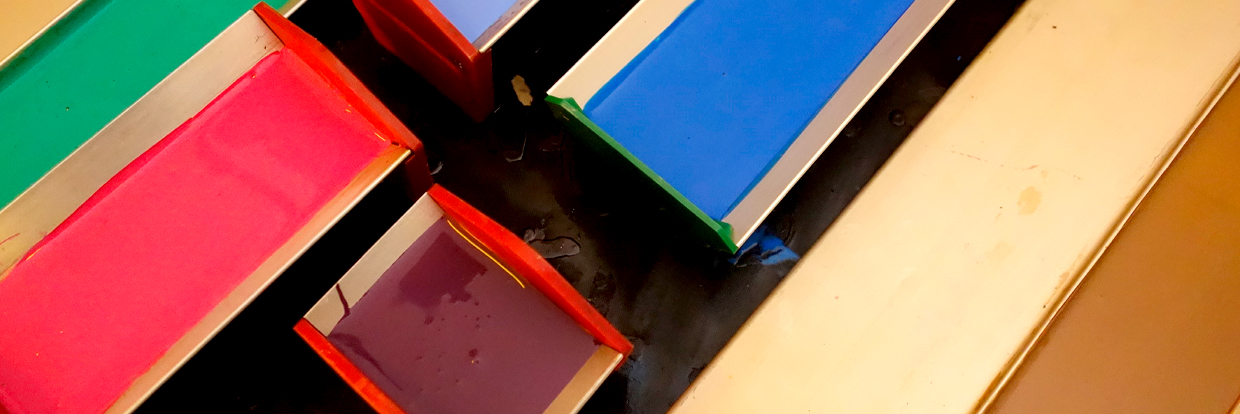
© Carlos Alguacil for Rittagraf
If what you are looking for is to learn step by step how you should emulsify screen printing screens, we recommend our Tutorial: Step by Step Screen Printing Coating.
Below we show you tips and solutions to the most common problems when emulsifying screen printing screens.
Can you coat screens without a screen printing lab?
While it's not ideal, you can coat screens in places without a proper lab. Screen printing emulsions are light-sensitive but more forgiving than other photographic products. You can coat screens in any dimly lit area, avoiding direct sunlight. After applying the emulsion, you need to dry the screen in a dry, light-protected space. If you work quickly, you can do it almost anywhere.
What happens if we use a smaller scoop coater and make multiple passes during coating?
Coating this way may cause problems, although it can be useful for simple textile jobs. However, it's not recommended for achieving fine details and professional work. Avoid coating in parts to achieve excellent results.
Is it possible to apply emulsion without a scoop coater?
If you don't have a professional scoop coating tool, you can apply the emulsion with a screen printing squeegee. It's a temporary solution in some cases, but it's not recommended as it hinders achieving excellent results and maximizing the potential of the emulsion and the process.
How do you determine the right amount of emulsion to apply to the screen?
The amount of emulsion applied depends on the emulsion density, the coating tool, the angle, the speed, and the coating technique. It's important to apply uniform and sufficient layers to cover the fabric threads. Poor coating leads to definition and ink loading issues. You can experiment with different quantities and application techniques to find what works best for you.
What happens if we apply only one layer of emulsion?
It's a common decision to save emulsion and reduce costs, but it's important to understand that applying only one layer of emulsion means not fully utilizing the technique and the product's potential. If you choose to do so, it's recommended to apply the emulsion on the inside (squeegee side) of the screen.
Will changing the coating layers affect the exposure times?
Yes. Any change in the coating method will alter the thickness of the photosensitive material and consequently affect the exposure times. Two people using the same emulsion with the same tool may require different exposure times.
Is it necessary to dry the screen horizontally?
Ideally, you should dry the screen horizontally with the print side facing down. However, modern emulsions have enough density to withstand vertical drying. Although not optimal, if horizontal drying is not possible, you can dry the screen vertically.
How long does the emulsion take to dry completely?
The drying time of screen printing emulsion can vary depending on factors such as temperature, humidity, and the applied thickness. To expedite the process, it's recommended to use a drying oven or a heat source, significantly reducing the drying time. For example, in a 5-square-meter space with a heat source positioned half a meter away and set to medium power, a 43-thread screen can dry in about 20 minutes, while a 90-thread screen may take between 10 and 15 minutes. It's important to ensure that the temperature doesn't exceed 40ºC (as per the manufacturer's instructions). Additionally, maintaining a clean space and preventing excessive air and dust movement by the heat source is crucial.
Although there is a belief that waiting 24 hours ensures complete drying, it's not necessary. However, it's important to note that the longer it takes to dry, the higher the possibility of dust particles settling on the emulsion. If natural drying is chosen due to the lack of a heat source, ensure that the emulsion is completely dry before exposing it. In this case, you can use a hairdryer at a safe distance to gently apply heat and remove any ambient moisture that the emulsion may contain.
Can I save the coated screen to expose another day?
Some screens can be stored with the emulsion coated, but not all emulsions retain their photosensitive properties when stored. It's important to check if the emulsion used allows for storing the screen without losing its qualities. Additionally, the screen should be kept completely dry and in a light-protected area.
How to prevent emulsion from peeling off during exposure or washing?
To ensure optimal adhesion of the emulsion to the screen, thorough cleaning before coating is essential. Make sure the screen is completely free of residue or grease before applying the emulsion. We recommend referring to our tutorial on screen cleaning for detailed instructions. Additionally, avoid touching the emulsion with bare hands, as the natural oils from the skin can affect its adhesion. If it's necessary to handle the emulsion and screen, use latex gloves.
If you experience adhesion issues during exposure or washing, it's advisable to review the coating process and follow the manufacturer's instructions. Also, consider the condition of the emulsion and adjust the exposure and washing times as needed.
What's the best way to clean the coating tools?
After using the scoop coater and other tools, it's important to clean them properly to prevent the emulsion from drying on them. Use water to remove emulsion residue and consider using a brush or sponge to assist. Make sure to rinse the tools thoroughly and dry them before storing. It's important for the coating tool to be completely clean and dry before each use. Check that the edge doesn't have any emulsion residue or other imperfections.
Remember that screen printing emulsion requires practice and patience. Don't hesitate to conduct tests and adjust your process according to your needs and the desired results.
